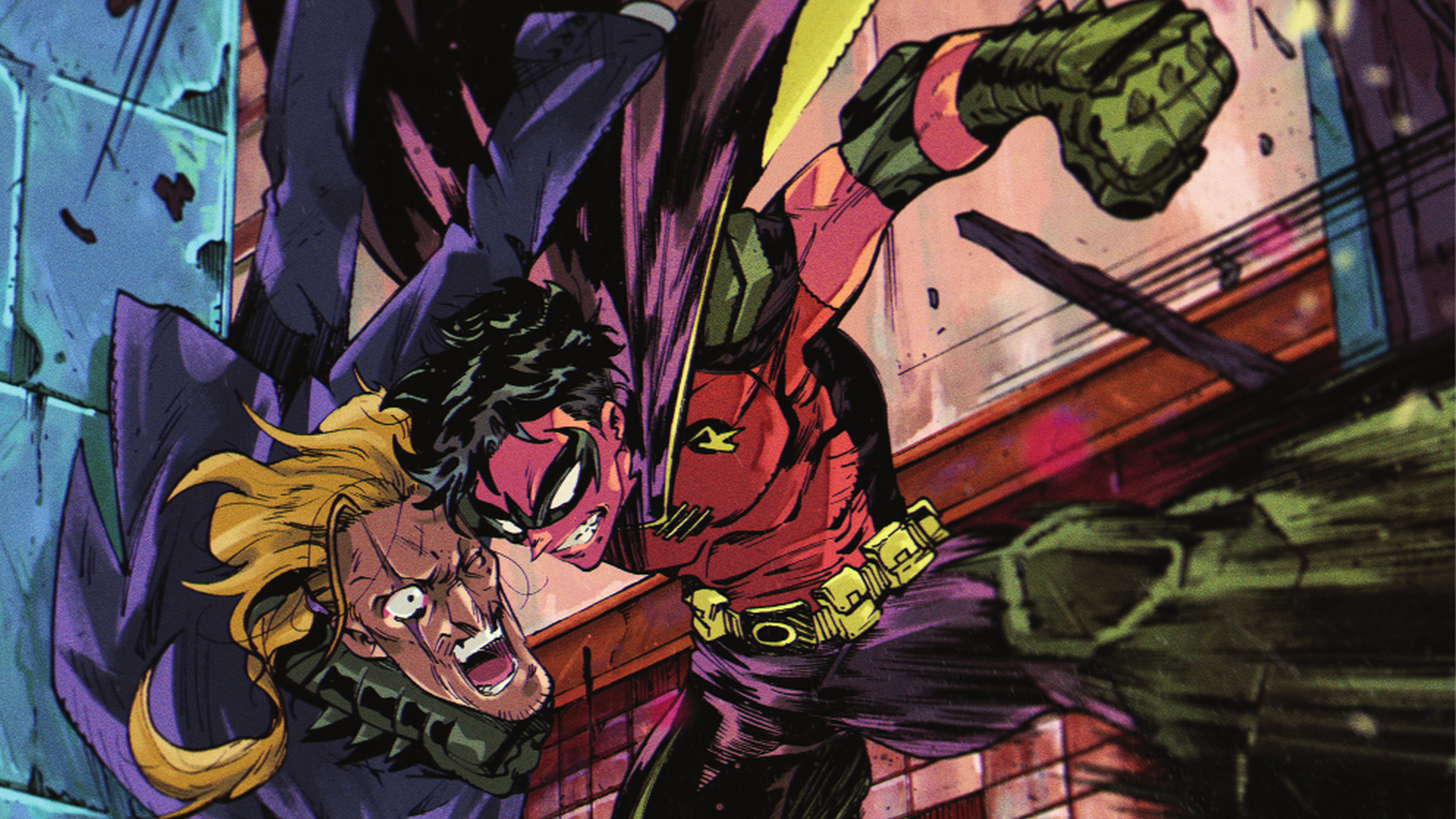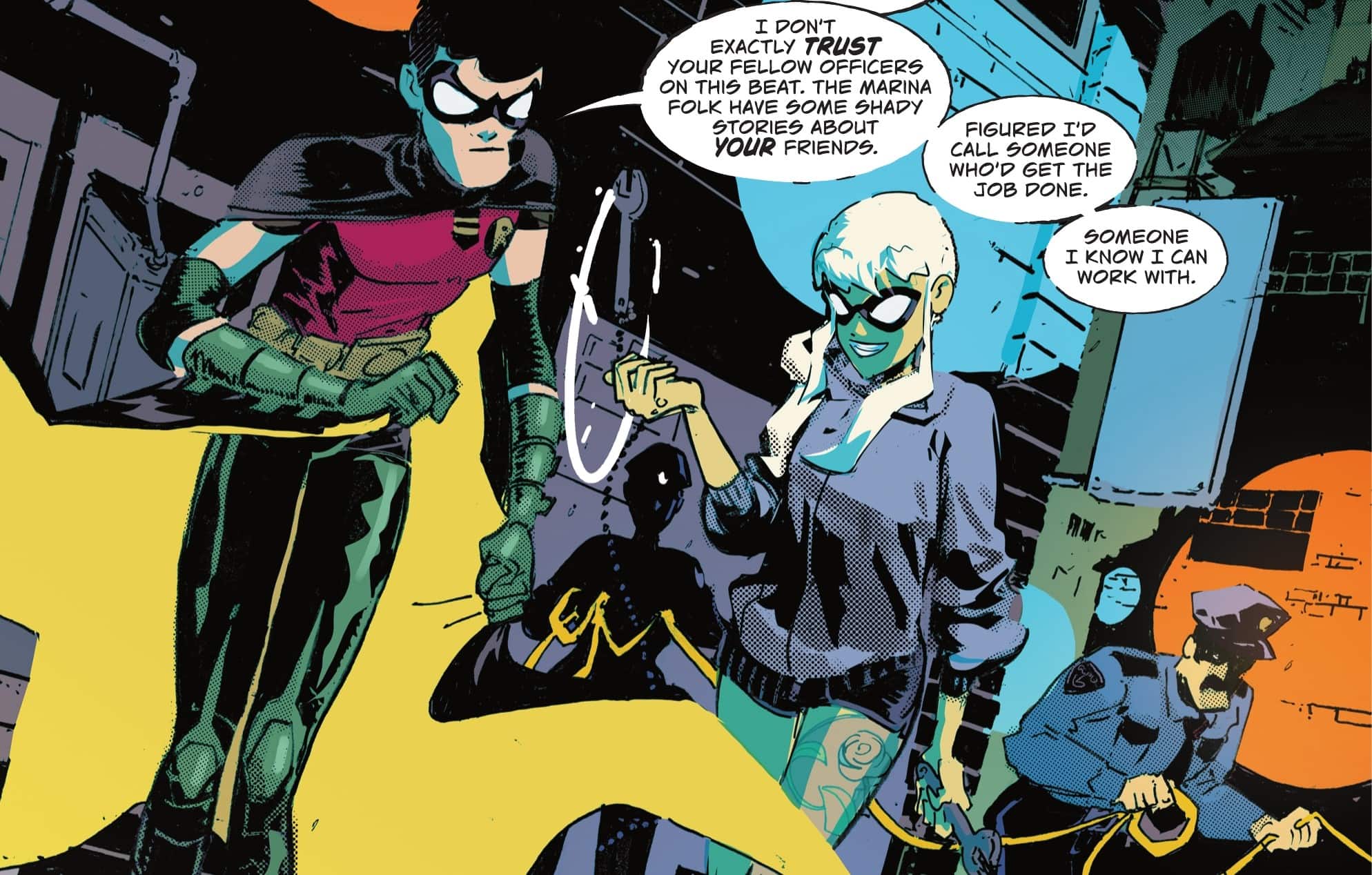
Comics Corner – The newly bisexual Boy Wonder doesn’t get a great coming out in ‘Tim Drake: Robin’
After drawing out the question of Tim Drake’s sexuality for over a year – the first hints coming in Batman: Urban Legends #4-6 back in August 2021 – the third Robin is now confirmed as bisexual, and dating his old friend Bernard. He’s also headlining his own ongoing solo title again, with the just-launched Tim Drake: Robin fitting into the red-breasted publishing slot vacated by the recently concluded Robin, which followed the younger Damian Wayne incarnation of the heroic identity.
For fans of the Batman family of characters, and of Tim in particular, it’s a big moment. The new series is Tim’s first headline book in more than a decade, and with Damian seemingly being positioned for other roles in comics such as Batman vs Robin, it’s time for Tim to reclaim his position as the Robin in the DC Universe. It’s also a chance for writer Meghan Fitzmartin and artist Riley Rossmo to provide some character growth for Tim, as he navigates his new relationship and identity.

Unfortunately, the debut issue feels like set-up for a retread of past stories, both those of Tim’s and of his older ‘brother’ Dick Grayson – the original Robin, now Nightwing. Part of this is an unavoidable reality of the cyclical nature of superhero comics, especially in DC’s frequently resetting continuity – not for the first time, Tim Drake: Robin finds the young hero setting out to define himself on his own terms, with a new base of operations and new supporting cast. Here, it’s Tim living off a boat in Gotham Marina, allowing him to keep an eye on a part of the city that’s often overlooked.
However, while the Marina itself is a fittingly spooky section of Gotham to focus on – its dimly lit docks and narrow side streets giving everything a macabre, Tim-Burton-meets-Jean-Pierre-Jeunet vibe – the ‘striking out on his own’ approach hits similar notes to both previous independent phases for Tim, and for Dick making Blüdhaven his home base.
Fitzmartin and Rossmo at least establish some interesting figures floating through Tim’s new life, with a cast of weird and wonderful neighbours living and working around the Marina. There’s mysterious handyman Tuna who works on the boats in the dockyard, lesbian couple Lauren and Tammy, their best friend Pie (a possibly non-binary character, only referred to with they/them pronouns), constantly smoking hipster couple Louie and Sophie, and nonplussed landlord James, who “didn’t even know boats floated until last year”. It’s a fun roster, and there’s plenty of potential for them going forward.

More interesting is the debut of Darcy Thomas, introduced as a member of the We Are Robin youth movement – Gotham youngsters taking vigilante justice into their own hands – who takes the codename Sparrow. There’s little to go on here, but she’s a fun, sparky new character, and her burgeoning heroic identity places her into the sidekick role that Tim usually occupies, while pushing Tim himself to step up as a mentor.
On the costumed front, the issue picks up a plot thread Fitzmartin set up in the DC Pride: Tim Drake Special. There, a holographic elephant was on the rampage, its activities loosely matching the story beats of Mark Twain’s The Stolen White Elephant, and here it’s another unlikely beast tearing up a Gotham district: an orangutan, this time re-enacting Edgar Allan Poe’s The Murders in the Rue Morgue. Quite who is fixated on classic detective stories and why they’re targeting Robin with hard-light role play versions is the key mystery going forward. Sadly, it’s not the most captivating mystery, and being effectively chapter two of the story, in the first issue of the series, is a poor start.
Ultimately, Fitzmartin feels more at home exploring Tim’s relationship dynamics than his costumed activities, but even here there are problems. Despite only appearing in the opening pages of the issue, Bernard’s presence is front and centre throughout. Tim angsts over whether he and Bernard are officially boyfriends or not yet, testing out the word and how it feels in his head. He reflects on how dating him is “different than anything I’ve ever felt before”. The pair banter about Bernard’s theories on Batman’s origins, and Tim later debates with Darcy over whether to reveal his secret identity to him.

It should all be rather sweet, capturing that sense of excitement at the start of a new relationship, especially with the added thrill of finally feeling comfortable in one’s own skin. Instead, it mostly feels oddly forced, or rushed. Getting to this solo series may well have taken over a year of real time, but in story terms, it’s been a rapid shift. While Fitzmartin has penned each of the steps along the way, little of Tim’s journey has been laid out on the page.
Between this first issue and the aforementioned DC Pride special, there are even moments where it feels as though Tim’s newfound bisexuality is undermined – that is, he’s written as gay, rather than bi – and other characters are warped to make that work. Take Batgirl Stephanie Brown, Tim’s longest serving love interest: in the Pride special, she is only slightly disgruntled that Tim had broken up with her, then giddy with excitement to meet Bernard. Here, she only gets a passing reference, as Tim remarks how she’d hate the boat he’s living on.
Of course, not all bisexual characters need to be portrayed as being torn between love interests of different genders – a monogamous portrayal of Tim and Bernard as a same-sex couple is perfectly valid. The issue is the route taken to get here, which doesn’t feel authentic for any character involved. Hopefully, it’s something that Fitzmartin will expand upon over future issues – if nothing else, the certainty of a monthly comic gives more narrative room to manoeuvre than disparate chapters in anthology books and one-shots, months apart, as fans have been drip fed over the last year.
Alas, it’s not just the story beats where Tim Drake: Robin disappoints. Rossmo’s highly stylised approach, a mix of dynamic framing, Dutch angles, and exaggerated forced perspectives, perfectly fits an anarchic character such as Harley Quinn – the last DC ongoing title Rossmo worked on – but feels a poor fit for the more serious members of the Batfamily. Even though this new era for Tim is meant to explore his greater lightness of being, having realised and begun to accept his bisexuality, Tim remains a highly competent over-planner, making Rossmo’s almost animated visuals an awkward match.

While there’s an energetic feel to Rossmo’s action pages, with an almost storyboarded approach to how characters move around the panels at times, civilian moments are lacking. Character design suffers too – the first time we see Tim, he’s effectively unrecognisable, looking more like an Archie Comics character. There are a few confusing moments too, such as floating panels depicting sign language around Darcy/Sparrow a few times, but no indication the character is deaf – she speaks and responds to Tim with no apparent issue. While this could perhaps be a clue to the identity of the unseen mastermind orchestrating the attack, without any further context yet, it’s hard to say.
Rossmo’s style is also a significant departure from the first part of the story in DC Pride: Tim Drake Special, where Belén Ortega provided art duties. While still possessing a somewhat gritty aesthetic, Ortega’s work was much more ‘superhero-y’ than Rossmo’s is, and seemed a better fit for story and characters. Cover artist Ricardo López Ortiz seems to strike a middle ground between Rossmo and Ortega’s approach to Robin, and it’s somewhat disappointing Ortiz isn’t on interior art. If nothing else, the switch from Ortega to Rossmo’s pages is going to make for a jarring visual transition when the storyarc is inevitably collected in a trade paperback.
A disappointing start for Tim Drake’s new era as Robin then, but not one devoid of promise. The relationship dynamics definitely need ironing out, but there’s definite potential in the setting and new supporting cast. It’s just sad that, after being without his own series for 11 long years, Tim Drake fans don’t have a first issue to be out and proud about.







